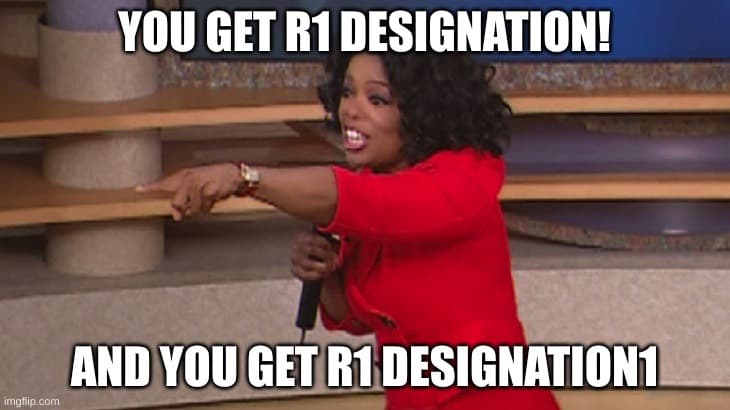The American Council on Education and the Carnegie Foundation for the Advancement of Teaching announced this week they are revising the Carnegie Classification of Institutions of Higher Education. It is a tiered system that classifies schools based on the caliber and breadth of their research activity. Most notably, they are drastically simplifying the qualifications for schools to earn the title of a “R1” research university to just focus on two factors: annual research spending and the number of doctorates a school awards in a year… Starting in 2025, a university can reach R1 status if it spends $50 million on research and awards at least 70 research doctorates annually, slimming the qualifications down from the current 10 metrics that schools must meet to gain the designation.
Only $50 million in research???
Geez.
SMU getting close —
SMU awarded 126 research doctorates in 2022 and conducted $42 million in research in 2021. "Our priorities have not changed,” SMU Provost Elizabeth G. Loboa said in an email. “SMU will continue to pursue R1 status…”
Everyone will become a R1. They need to create R0 with the old R1 requirements. May UH just needs to concentrate on becoming AAU.
Unless they introduce higher level tiers that require greater spending on research,
the value of being R1 will carry much less weight and prestige.Taking into account inflation,
I would think the thresholds should be going up.
Why would they do this ? Would really like to understand the motivation.
I’m surprised at the overall increase in the number of institutions.
| Year | R1 | R2 | R3 | Total |
|---|---|---|---|---|
| 2021 | 146 | 134 | 189 | 469 |
| 2018 | 131 | 132 | 161 | 423 |
| 2015 | 115 | 107 | 112 | 334 |
| 2010 | 108 | 98 | 89 | 295 |
| 2005 | 96 | 102 | 81 | 279 |
If you want to know why they are doing this, I have a sneaking suspension that all of this is related to the recent Supreme Court ruling on Affirmative Action and the ensuing backlash against the college admissions industrial complex (my term).
Due to the ruling, the admissions criteria for many colleges and universities are coming under more scrutiny, particularly, top public institutions, which are increasingly mirroring the exclusivity of their private university counterparts.
Many state governments, and more importantly, taxpayers, are starting to ask themselves why they should give their hard earned money to such institutions. In addition, as people begin to focus on the “non-racial” affirmative action (i.e. legacy admits, children of donors, non-revenue sports scholarships, testing criteria, etc.), the ability of people from top high schools to gain admissions to these top schools will get more difficult.
So, rather than make even more people upset, the Higher Education industrial complex has decided to change the ranking and credential system so that more schools seem elite, thus reducing the pressure to let in more students to the UVAs, UTs and UNCs of the world.
I call BS on it; I have stated my position on here repeatedly that public colleges and universities, especially land grant colleges like TAMU, Ga Tech, Va Tech, Cal, Wisconsin, Michigan State, Penn State, Purdue, etc., were never intended to be super selective institutions. They were granted free land by the federal government under the Morrill Act, explicitly, to educate the general populace in trades, namely, agriculture and engineering, to benefit the populace. Instead, these schools are wasting scarce resources on football programs, tech research, and other non-essential training that benefit only the wealthy few. Thus, these schools are just trying to buy themselves more breathing room so that they can continue to overcharge students by creating artificial scarcity. All this stuff is leading to increased borrowing, increasing student debt, increasing financial pressures on parents and thus an increasingly unhappy public.
If you want to learn more about this, look up a man named Scott Galloway. He has been harping on this for years, and at first I sort thought he was full of it. However, as I have gotten older and just having had a kid go through this, he is 100 percent right.
It is a joke and I am starting to believe that the whole system needs to be torn down root and stem and started over.
I don’t think the recent SC ruling on AA is the cause, as the number of institutions that are in the
R1 club has been going up since 2005. The data shows there was a staggering 50% increase in number of R1 institutions between 2005 and 2021. And all this was pre Supreme Court ruling.
Now I do think something funny is at work here in your aptly called CAIC. It just seems strange the
threshold level would not be indexed for inflation and I don’t accept we have 50% more elite schools during the 2005-2021 time period.
I did do a google search on Scott Galloway, but there is lots of info out there on this guy, and I’m just not motivated enough to dig thru all the stuff on him to understand his take on this. I’m a bit lazy tonight.
So, rather than make even more people upset, the Higher Education industrial complex has decided to change the ranking and credential system so that more schools seem elite, thus reducing the pressure to let in more students to the UVAs, UTs and UNCs of the world.
It sounds …hate to say it…but like a conspiracy theory thing. But, I don’t have an alternate
explanation as to why the Carnegie folks would want to devalue themselves.
And to get back to the inflation thing, it is big; roughly 50% during this time period.
The dollar had an average inflation rate of 2.41% per year between 2005 and 2022, producing a cumulative price increase of 49.85%. This means that prices in 2022 are 1.50 times as high as average prices since 2005, according to the Bureau of Labor Statistics consumer price index.
$1 in 2005 → 2022 | Inflation Calculator.
It just doesn’t make sense. R1 should at least be at $75 million if R1 was $50 million in 2005.
I agree - they’ve been allowed now to create defacto jucos such as the rellis campus at A&M just to admit more folks in and keep handing out contracts
When they struck separate but equal down decades ago not to fund an African American counterpart so they can hog the wealth is the telling sign - then they eliminate all trades,
What does SMU research, how to keep pop collars to stay up?

Good points all NRGcoog. I am not generally one to revel in conspiracy theories, but, when evidence suggests that many public institutions are (i) purposefully keeping entry level class sizes down, (ii) encouraging students to go to other, lower-funded, lower quality schools, or in some cases, actively encouraging kids to not even go to college, and (iii) now actively attempting to become “state affiliated” rather than “public or state funded” institutions, something is amiss.
In some states, the reason why many legislatures are not funding universities more is because they are demanding that in exchange for additional funding, schools must (i) increase the entering classes and (ii) reduce tuition. State schools don’t want to do either.
I just think that we are too quick to blame state legislatures and governments for failing to fund state universities, but fact is, in many cases those legislatures have good reasons not to, at least not without substantial changes.
So again, just tie this in to the R1 designation - realize that the member schools really run this. So, they decide who and what is considered “R1”.
